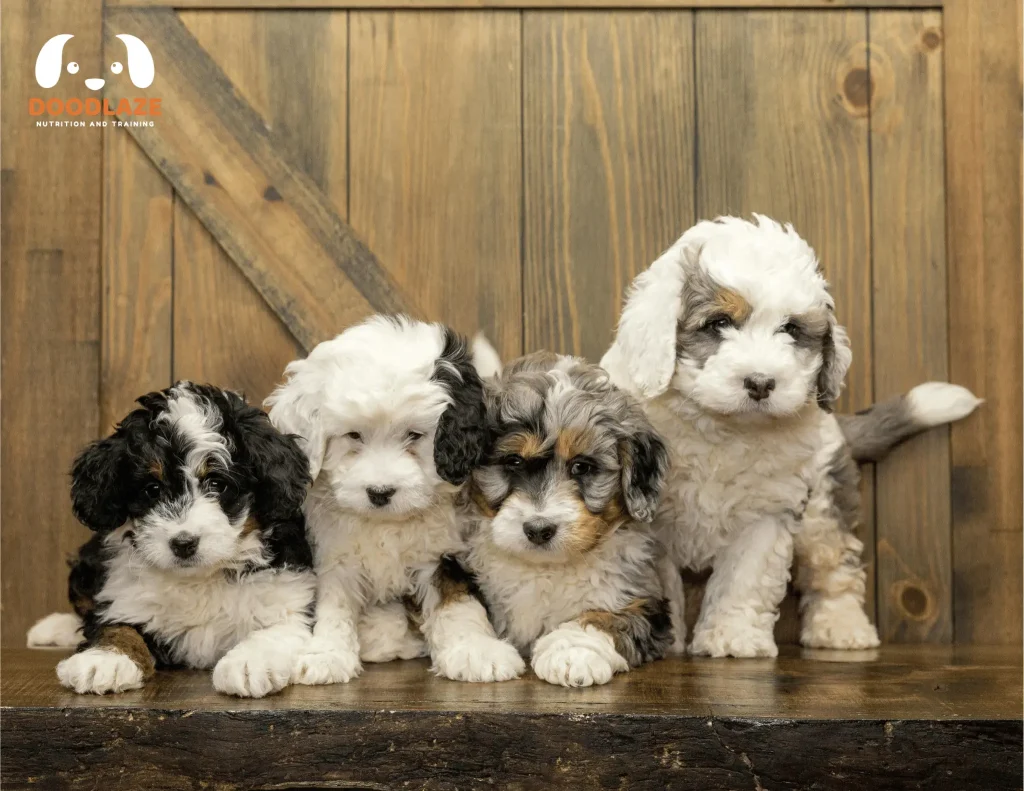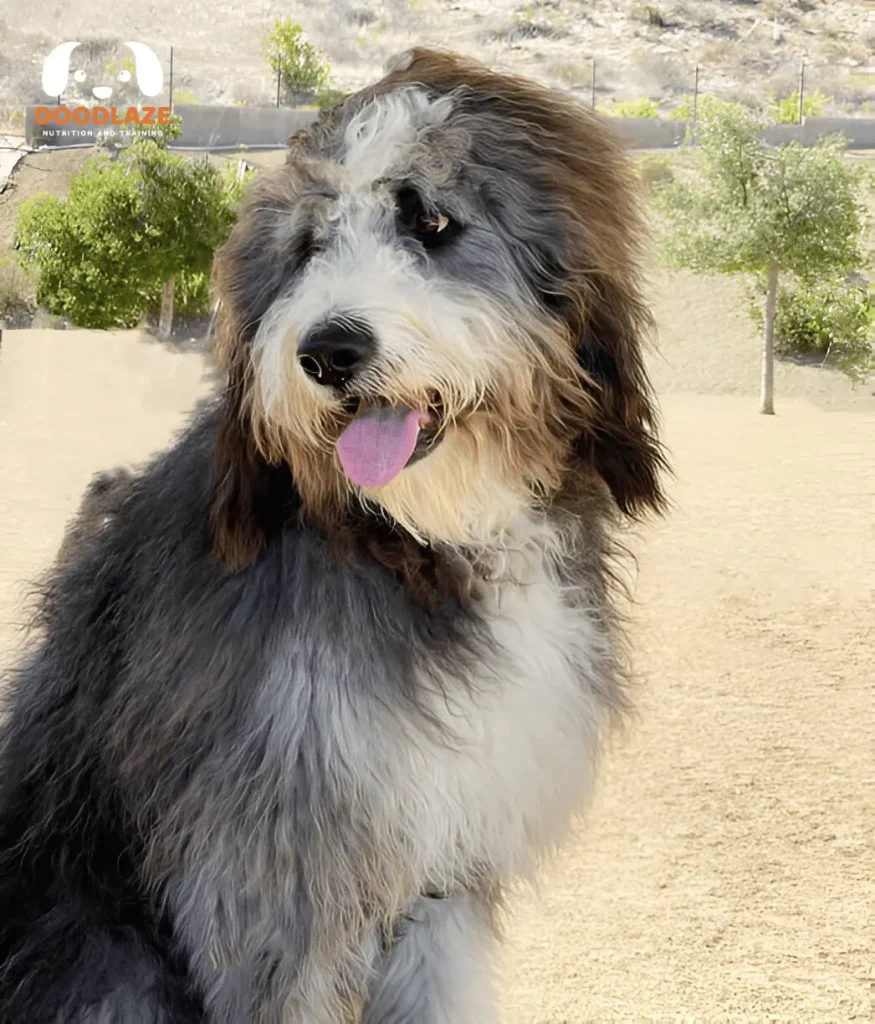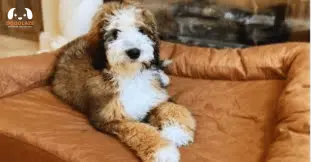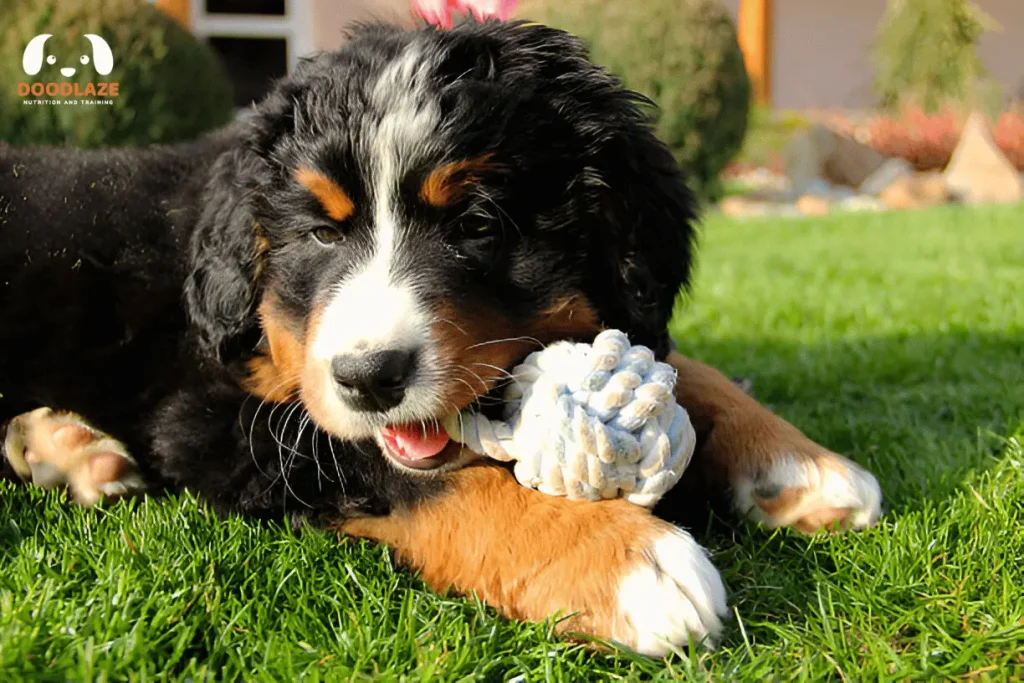Bernedoodle Colors Complete Guide 2024 , Coat, Types, & Sizes
Bernedoodles are often recognized for their Tri-Color coats, similar to the Bernese Mountain Dog. However, thanks to their Poodle genetics, these dogs also sport a diverse array of other colors and patterns.
I have invested considerable effort in studying the genetics behind these coat variations. Below you’ll find a simple focus on the various colors of Bernedoodle. It’s important to note that not every litter will have all these colors. We use genetic testing on the parents to predict the colors of the puppies in each planned litter and list these possibilities accordingly.
Bernedoodle Puppy Colors
Bernedoodles are available in a variety of colors:
F1 Bernedoodles display several patterns, including the traditional tri-color seen in Bernese Mountain Dogs, along with tri-color Phantom, Phantom, tri-color Sable, Sable Phantom, Sable and white, Brindle and white, Black, black and white, parti, tri-color Merle, Merle and white, and Merle Phantom.
F1B Bernedoodles expand this palette, including all the colors of the F1s plus additional hues such as cream, cream and white, chocolate, chocolate and white, and chocolate phantom.

Colors for Multi-generation Bernedoodles mirror those available in F1B Bernedoodles.
It’s also key to understand that F1 Bernedoodles typically do not exhibit cream, cream and white, chocolate, tri-color chocolate, or chocolate and white. These specific colors necessitate that both parents possess these color genes, which Bernese Mountain Dogs do not carry.
Tri-Color Bernedoodle
A tri-color Bernedoodle features a distinctive coat of black, rust, and white. These Bernedoodles might show white markings on their faces, but this is not always the case. A classic tri-color Bernedoodle bears a strong resemblance to a Bernese Mountain Dog. These dogs can exhibit either a prominent white mask or more subtle white markings. You can view the different styles on our Tri-color Bernedoodle page.

The tri-color pattern in Bernedoodles, a nod to their Bernese Mountain Dog heritage, incorporates three distinct colors. The coat can showcase various combinations of black, brown, tan, rust, apricot, red, white, and cream. The primary color is a deeper shade, complemented by white accents on the face, chest, and extremities. Do you know about Bernedoodle Shedding.
Merle Bernedoodle
Merle Bernedoodles are among the less common types of Bernedoodles, distinguished by their eye-catching coat pattern. This isn’t simply a solid color but a pattern where a base color like black or brown is sprinkled with patches of lighter blue, gray, or red, creating a dappled look. The gray patches on black bases can sometimes seem blueish, earning them the label of blue merle.
The gene responsible for the merle pattern is relatively rare in both Poodles and Bernese Mountain Dogs, the breeds that cross to produce a Bernedoodle. To get a merle Bernedoodle, breeders might pair a Poodle with a Bernedoodle that has a merle coat. It’s important for ethical breeders to avoid mating two merle Bernedoodles together, as this can lead to health issues in the puppies, including blindness and deafness.

Sable Bernedoodle
Sable Bernedoodles are a popular variant of the Bernedoodle breed, noted for their distinctive coat coloration. Their fur has a unique feature where each hair is black at the tip, standing out against a solid base color that varies widely. The amount of black tipping varies, influencing the overall appearance of the coat. A notable characteristic of sable Bernedoodles is their ability to change color as they grow older. Generally, the dark-tipped fur lightens considerably by adulthood, although their ears often retain darker shades.

The term “sable” refers to this specific fur coloration in Bernedoodles, where the black tips are not confined to any particular area or pattern. Some sable Bernedoodles may also exhibit patches of white from their Bernese Mountain Dog heritage. These dogs are visually striking and attract a lot of attention for their beautiful coats.
Brindle Bernedoodle
Brindle Bernedoodles are known for their distinctive coat pattern, which is often likened to tiger stripes, though it is much more subdued. This pattern can appear on a blue or red base color. As the dogs grow, their brindle pattern tends to become more pronounced. There are a few variations of this coloring, including solid brindle, brindle with patches of white from the Bernese Mountain Dog, or an abstract brindle that may look tricolored. This is why some people might refer to them as brindle tricolors, although in other dog breeds this pattern is simply known as brindle.
From birth, Brindle Bernedoodles sport their characteristic stripes. As they age and their fur grows longer, these stripes begin to blend more into the overall coat color. You can observe this transformation in photos comparing a newborn Brindle Bernedoodle to the same dog at six weeks old; the puppy retains its stripes, but they meld into the longer fur. Young Brindle Bernedoodles often resemble sable tricolored dogs in appearance due to their similar fur patterns.
Phantom Bernedoodle
Phantom Bernedoodles are known for their distinctive coat patterns that resemble the appearance of tri-colored Bernedoodles but with fewer white areas and more pronounced brown shades.
Generally, the most common color scheme for these dogs is black with tan accents. These tan marks are prominently displayed on their face, chest, legs, and paws, making the black base of their body stand out even more. Although this color type is less common among Bernedoodles, it is quite eye-catching.
The “phantom” term refers to a coat where one primary color covers most of the body, highlighted by ‘tips’ or patches of a secondary color. This pattern is similar to what you see on breeds like Rottweilers or Dobermans.
Phantom can appear in various combinations, such as silver with white points, chocolate with cream points, or black with tan points. In black phantoms, the secondary tan color commonly appears on the legs, chest, cheeks, and eyebrows, adding a striking contrast to the primary black color.
Phantom tricolor Bernedoodles
Phantom tricolor Bernedoodles are eye-catching dogs with a coat featuring black, rust, and white colors. These dogs often get mixed up with regular phantom Bernedoodles because they look similar. The main difference is that the tricolors usually don’t have white markings on their faces. Their coat usually has a black base, tan on the legs, and white areas that may appear as a small patch or cover the entire chest.

Black and White Bernedoodles, also called Tri Bernedoodles, have a black and white coat but include additional copper marks around the face, legs, and above the eyes. The two-color black and white coat is one of the less common Bernedoodle colors, but the most popular tri-color pattern features black, white, and either tan or brown.
Bernese Mountain Dog Colors
Bernese Mountain Dogs are usually recognized by their three-colored coats. They usually have a deep black main color with white and either rust or tan spots. You can find the rust or tan spots above their eyes, on their cheeks, sides of the chest, legs, and beneath the tail.
The white is noticeable on their face, between their eyes, across the chest, around the neck, and on their paws.
Poodle Colors
Poodles are commonly found in a variety of solid shades, including black, blue, gray, silver, brown, red, apricot, cream, cafe au lait, silver beige, and white. They can also have combinations of colors such as black and brown, black and tan, black and apricot, black and cream, brown and apricot, and brown and white, among other mixes of the solid colors mentioned earlier.
Red and White Bernedoodle
The red and white Bernedoodle sports a striking red and white coat, a less common color pairing. Naturally, these dogs have a predominantly red coat covering most of their body, with white fur on their chest, face, paws, and legs.
There’s also a version known as the parti red and white Bernedoodle, where the main coat color is white, and red patches appear on the face, ears, and occasionally on the back.
Mini Bernedoodle Colors
Mini Bernedoodles come in a variety of colors, including the same tri-color pattern seen in larger Bernedoodles, as well as solid black, chocolate, or white. These little dogs can also have merle, phantom, and sable patterns. If a Mini Bernedoodle is a backcross, meaning it has more Poodle genetics, it tends to show more Poodle traits.
If you’re interested in a tri-colored Mini Bernedoodle, your best bet might be with an F1 Mini Bernedoodle. It’s a good idea to talk about these possibilities with the breeder you’re considering, as they can provide information on the genetic testing of their dogs’ coats.
FAQs
Wrapping Up
As of today, the diversity in Bernedoodle colors and patterns reflects a deep appreciation for genetic variety. These dogs not only bring joy with their friendly personalities but also offer a spectrum of appearances that can cater to various preferences.
From the elegant tri-colors that mimic their Bernese ancestors to the rare merle patterns, Bernedoodles continue to charm families with their unique looks and lovable traits. Whether you seek a vibrant phantom or a classic black and white, each Bernedoodle brings its own special flair to the mix, ensuring that every dog lover can find their perfect match.


2 Comments